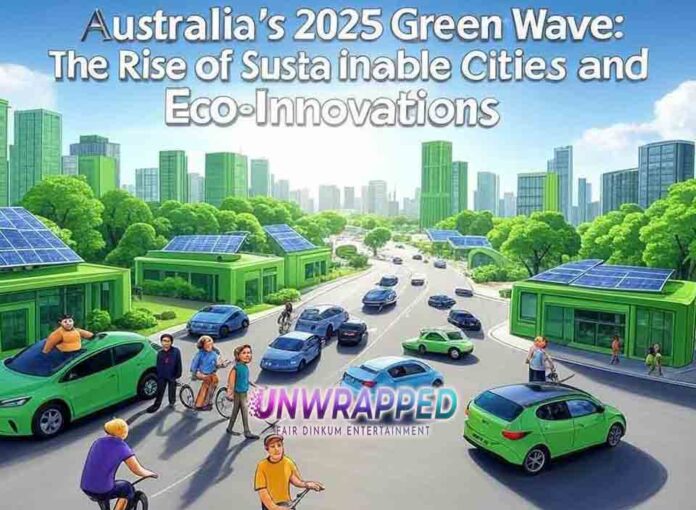In 2025, Australia will be at the forefront of a global movement toward sustainability, with cities adopting green technologies, policies, and lifestyles at an unprecedented pace. From solar-powered streets to zero-waste initiatives, this article delves into the innovations making Australia a blueprint for the world’s sustainable future.
1. The Sustainable City Leaders of 2025
1.1 Melbourne – The Sustainable Heartbeat
- Green Building Boom: Over 30% of new constructions now use sustainable materials and aim for carbon neutrality.
- Public Transport Revolution: Expansion of the tram network powered by renewable energy, reducing car dependency.
1.2 Sydney – The Blue-Green Metropolis
- Water-Sensitive Urban Design: Incorporating wetlands and bioswales to manage stormwater, enhancing urban ecology.
- Smart Waste Management: IoT-enabled bins signal when they’re full, optimizing waste collection and reducing overflow.
1.3 Adelaide – The Solar City
- World-Leading Solar Coverage: More solar panels per capita than anywhere else in the world, thanks to government incentives.
- Urban Farming: Rooftop gardens and vertical farms integrated into city planning to reduce food miles.
1.4 Brisbane – The Eco-Innovator
- Green Corridors: Connecting green spaces across the city, promoting biodiversity and offering recreational areas.
- Electric Ferry System: The Brisbane River now hosts a fleet of electric ferries, reducing emissions from public transport.
2. Tech Innovations Driving the Change
- AI in Waste Management: Predictive systems forecast waste generation patterns, enhancing recycling and composting processes.
- Microgrids: Small-scale, localized energy systems in neighborhoods, improving power reliability and integrating renewable sources.
- Energy Harvesting Roads: Queensland and Victoria test roads that collect kinetic energy from traffic to power streetlights.
3. Policy Frameworks for Sustainability
- National Green Deal: A comprehensive policy aiming for carbon neutrality by 2050, with key 2025 milestones.
- Local Government Initiatives: Bylaws promoting green roofs, rain gardens, and energy-efficient public spaces.
- Incentives for Green Tech: Tax breaks, grants, and subsidies for businesses and households adopting green technology.
4. Community Engagement and Lifestyle Changes
- Eco-Neighborhoods: Communities like ‘EcoVille’ in Melbourne encourage shared resources and communal efforts to reduce carbon footprints.
- Green Education: Schools and universities integrate sustainability into curriculums, nurturing a new generation of eco-conscious citizens.
- Cultural Shift: A growing trend toward minimalism and “repair, reuse, recycle” ethos, lowering waste at the consumer level.
5. Challenges and Future Outlook
- Infrastructure Costs: High initial investment in green tech, though offset by long-term savings and environmental benefits.
- Urban Sprawl vs. Sustainability: Balancing city expansion with green initiatives, especially in rapidly growing regions like Perth.
- Looking Ahead: Innovations in water conservation, clean energy storage, and sustainable transport options are on the horizon.
Conclusion
By 2025, Australia’s unwavering dedication to sustainability has reshaped its urban landscapes, making it a global example for eco-friendly living. This green wave is more than just an environmental shift—it’s a cultural and economic revolution, showcasing how sustainability can drive innovation, attract skilled talent, and enhance overall quality of life.
Call to Action
- Explore Further: Plan a visit or conduct research on these pioneering cities to witness sustainable urban planning in action.
- Get Involved: Join local sustainability groups or start your own green initiative.
- Stay Updated: Follow progress through local government updates and sustainability forums.
Final Word & A Word of Caution
While Australia’s progress in renewable energy and eco-innovation is commendable, we must remain vigilant to ensure that these advancements are not exploited as a means of control—whether through monopolies over new technologies or unfair pricing structures. As green power scales up, energy costs should trend downward, making sustainability accessible to everyone. Constant oversight and inclusive policies will help guarantee that the benefits of clean energy and innovative technologies are shared widely and affordably, rather than consolidating power in the hands of a few.
See Also: The Ultimate Guide to Choosing the Best NBN Plan in Australia for 2025










